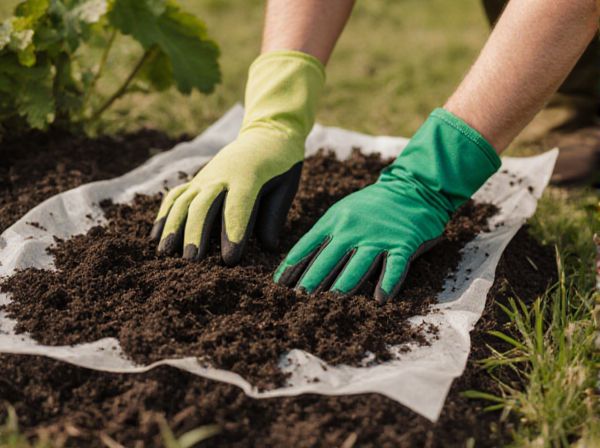
Sheet mulching vs traditional tilling Illustration
Sheet mulching improves soil health by layering organic materials that suppress weeds, retain moisture, and promote beneficial microbial activity without disrupting soil structure. Traditional tilling disturbs the soil, often leading to erosion, loss of nutrients, and reduced microbial diversity. Embracing sheet mulching in permaculture enhances long-term soil fertility and ecosystem resilience compared to conventional tilling methods.
Table of Comparison
| Aspect | Sheet Mulching | Traditional Tilling |
|---|---|---|
| Method | Layering organic materials to suppress weeds and enrich soil | Turning soil with tools or machinery to prepare planting beds |
| Soil Health | Improves soil structure, microbial diversity, and moisture retention | Disrupts soil organisms and structure, risking erosion and compaction |
| Weed Control | Effective through physical barrier and organic matter breakdown | Relies on mechanical disturbance to remove weeds |
| Labor | Lower labor after initial setup, minimal maintenance | High labor and frequent soil disturbance required |
| Soil Fertility | Gradual nutrient release from decomposing layers | Depends on external fertilizers and amendments |
| Environmental Impact | Promotes carbon sequestration and reduces erosion | Increases carbon release and soil degradation risks |
| Suitability | Ideal for sustainable permaculture and regenerative practices | Common in conventional agriculture and gardening |
Understanding Sheet Mulching and Traditional Tilling
Sheet mulching enhances soil health by layering organic materials that suppress weeds, retain moisture, and promote microbial activity, creating a nutrient-rich environment for plants. Traditional tilling involves mechanically turning the soil to prepare gardens, which can disrupt soil structure, reduce beneficial organisms, and increase erosion risks. Understanding these methods highlights sheet mulching as a sustainable alternative that improves soil fertility and conserves resources compared to conventional tilling practices.
Core Principles Behind Each Method
Sheet mulching preserves soil structure and promotes biodiversity by layering organic materials that enhance microbial activity and moisture retention. Traditional tilling disrupts soil ecosystems to loosen compacted earth, facilitating aeration and immediate nutrient mixing but often leading to erosion and microbial imbalance. Both methods reflect core principles: sheet mulching prioritizes regenerative practices and long-term soil health, while tilling emphasizes short-term productivity and soil preparation.
Environmental Impact: Comparing Soil Health
Sheet mulching enhances soil health by promoting microbial diversity, retaining moisture, and reducing erosion, unlike traditional tilling which disrupts soil structure and depletes organic matter. The layered organic materials used in sheet mulching mimic natural forest floors, fostering nutrient cycling and carbon sequestration. In contrast, tilling accelerates soil degradation and increases greenhouse gas emissions, undermining long-term soil fertility.
Weed Control Effectiveness
Sheet mulching suppresses weeds by blocking sunlight and promoting beneficial microbial activity, creating a dense barrier of organic material that inhibits weed germination more effectively than traditional tilling. Tilling often disturbs weed seeds, bringing them to the surface and encouraging rapid germination, which can lead to persistent weed problems. By maintaining soil structure and enhancing microbial diversity, sheet mulching provides a sustainable and long-term solution to weed control in permaculture systems.
Water Retention and Moisture Management
Sheet mulching significantly improves water retention by layering organic materials that absorb and slowly release moisture, reducing evaporation compared to traditional tilling which disturbs soil structure and increases water runoff. This method enhances soil microbial activity and organic matter content, promoting better moisture infiltration and long-term soil fertility. Traditional tilling often leads to compaction and decreased water-holding capacity, whereas sheet mulching creates a protective mulch layer that stabilizes soil temperature and maintains consistent moisture levels.
Labor, Time, and Cost Differences
Sheet mulching significantly reduces labor intensity compared to traditional tilling by eliminating the need for deep soil turnover and extensive physical effort. Time investment is also lower, as sheet mulching can be applied quickly using layers of organic materials, whereas tilling requires prolonged machinery or manual work. Cost savings arise from reduced fuel or tool expenses and minimal soil amendment requirements, making sheet mulching a more sustainable and economically viable method in permaculture practices.
Long-Term Sustainability in Garden Systems
Sheet mulching enhances long-term sustainability by preserving soil structure, increasing organic matter, and promoting microbial diversity, which traditional tilling often disrupts. Unlike tilling, which accelerates soil erosion and depletes nutrients, sheet mulching builds a resilient soil ecosystem that supports plant health and reduces water runoff. This method improves moisture retention and carbon sequestration, making it a superior choice for sustainable garden management in permaculture systems.
Effects on Soil Microorganisms and Biodiversity
Sheet mulching enhances soil microorganisms and biodiversity by creating a protective organic layer that retains moisture and nutrients, fostering beneficial microbial activity and diverse habitats for soil fauna. Traditional tilling disrupts soil structure, exposing microorganisms to air and UV light, which reduces microbial populations and diminishes soil biodiversity. The increased microbial biomass and fungal networks in sheet mulched soils improve nutrient cycling and plant health compared to the degradation caused by frequent tilling.
Practical Applications: When to Use Each Method
Sheet mulching is ideal for creating new garden beds, improving soil health, and suppressing weeds without disturbing soil structure, making it practical for areas with poor soil or for permanent planting zones. Traditional tilling is better suited for preparing seedbeds for annual crops and integrating amendments quickly when immediate soil aeration and mixing are needed. Choosing between the two depends on goals: use sheet mulching for long-term soil regeneration and traditional tilling for rapid soil preparation and planting cycles.
Permaculture Perspectives on Mulching vs. Tilling
Sheet mulching in permaculture preserves soil structure, enhances microbial life, and improves moisture retention by layering organic materials directly on the ground, reducing the need for soil disturbance. Traditional tilling disrupts soil ecosystems, accelerates erosion, and depletes soil nutrients, ultimately weakening plant resilience and long-term fertility. Permaculture prioritizes sheet mulching for sustainable soil health, biodiversity support, and minimal environmental impact.
Sheet mulching vs traditional tilling Infographic

 gardendif.com
gardendif.com